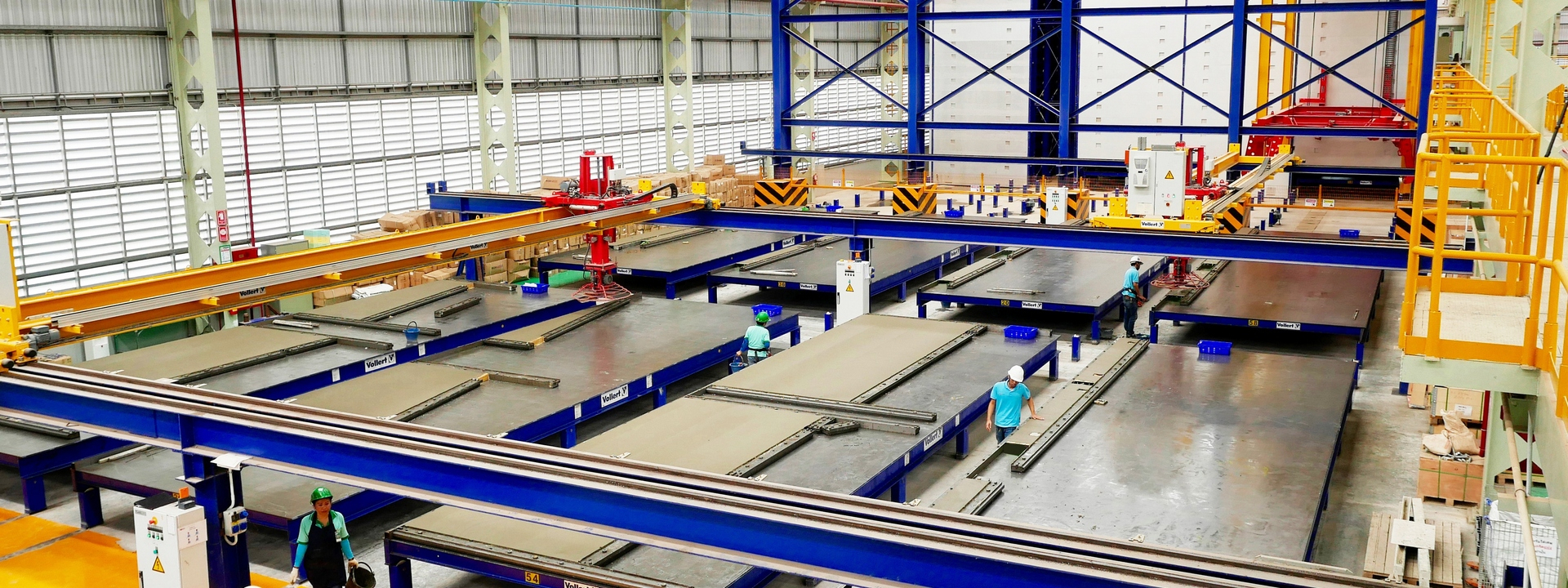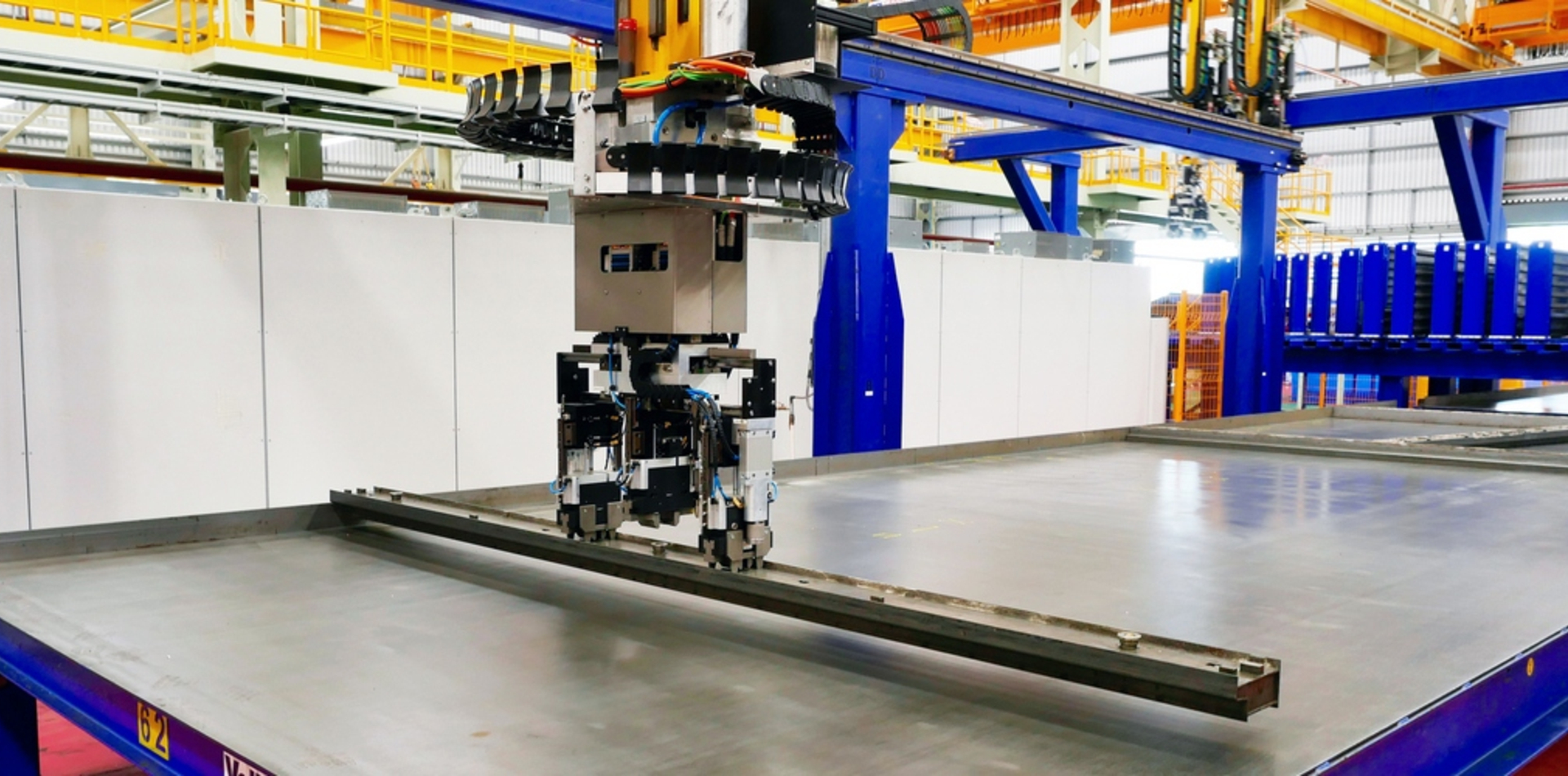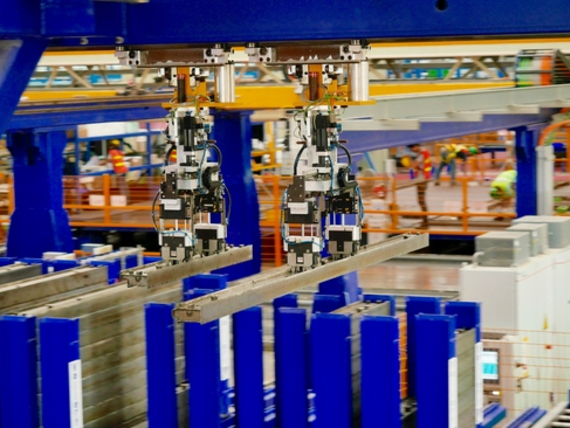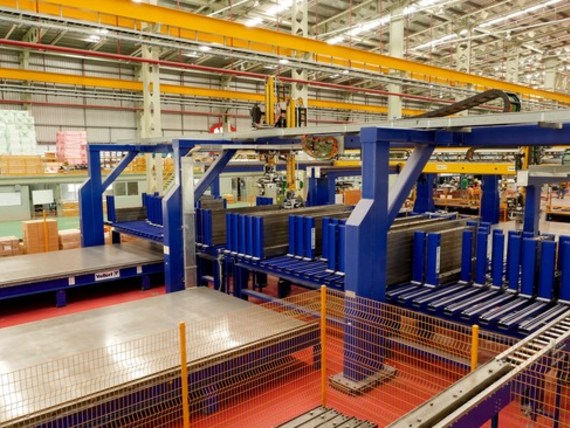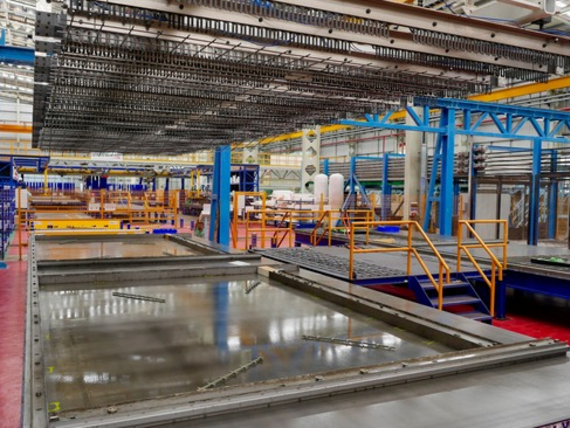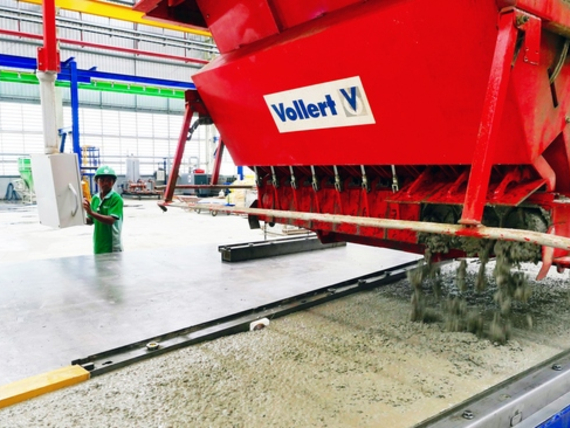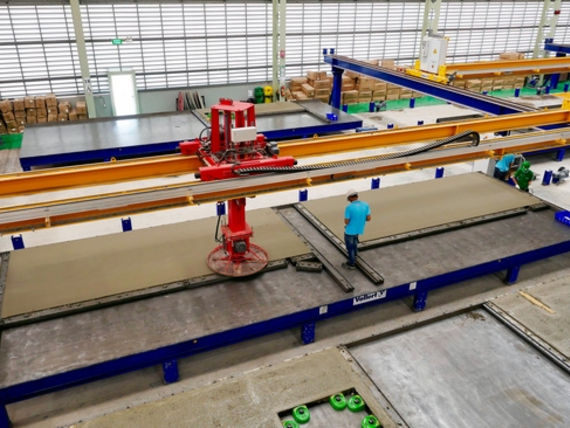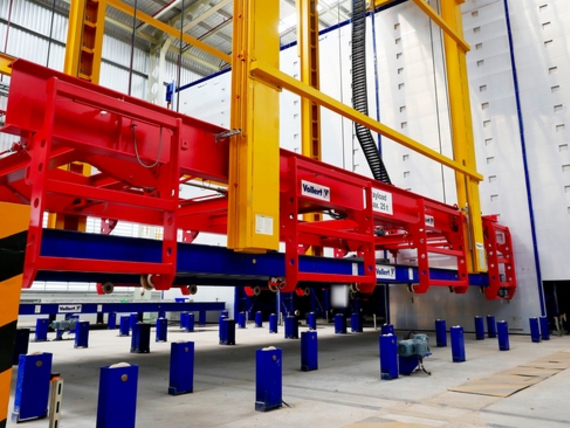In the future, up to 2,200,000 m² of solid concrete parts will be produced annually in Sarabury and Chonbury, to the north-east and south-east of Bangkok. For walls and slabs in grade A, premium quality, the SCG group (Siam Cement Group) relies on state-of-the-art plant technology and a sophisticated stockyard solution for efficient loading and logistics processes.
Investment isn't self-evident. Currently active exclusively as one of the leading cement producers in the ASEAN region, signs pointed to further growth in 2013 and to the development of additional strategic sustainable business areas. For several years, Thailand has increasingly focused on precast construction techniques as a modern, low-cost building system. "For us, this was nevertheless new territory, and the corresponding plant technology was a big challenge," describes Vitas Suriyachan, On-Site Manager at SCG Cement, with regard to the initial situation at the start of the project. "Building in precast architecture requires a lot of know-how. With Vollert, we have selected an experienced plant designer that not only supplies the latest technology, but also adjusts the technical production processes precisely to customer requirements."
2,200,000 m² solid concrete parts for a new residential area in rural regions
The market potential for new affordable residential area, especially in the growing rural regions in the districts around Bangkok, is immense. "With new construction projects, real estate developers are increasingly tapping in to the outer city districts and communities," explains Steffen Schmitt, Executive Sales Director Asia at Vollert. In order to implement the required solid concrete parts capacities of more than 2,200,000 m², the decision was made to erect a new, highly modern precast plant for plane wall and slab elements on green fields in the strategically important cities of Sarabury and Chonbury. The basis is formed by a unified technology platform of Vollert plants. CAD/BIM software from Precast Software Engineering for building modelling provides the basic data. This results in selection options for capacity distribution of order between the two locations. In addition to the geometry of the concrete parts, the project department data also include information about the required output quantities, time lines, and all logistics flows. "This reduces the period of time from the concept of the real estate developer to the delivery of the precast elements to the construction site to a fraction," explains Schmitt. "The system technology has been designed so flexibly that concrete parts of featuring even the most diverse geometries are also able to be produced. Switching between processes from one product to the next takes place at short notice."
Building Information Modelling (BIM) and highly automated plant technology
From serial production of standardised wall and slab elements to complex special parts, all processes ranging from 3D building planning and the production of precast parts to delivery to the construction site are completely matched to each other. Scalable 3D data for precast concrete elements are derived from building models (Building Information Modelling/BIM). In this case, the BIM solution Allplan Precast from Precast Software Engineering offers powerful functions for high-efficiency and high-quality planning of automated precast elements. The Unitechnik master computer accepts the data models directly from the CAD system and controls the production process fully automatically. Thus the plant operator has an overview of the most important economic key figures at all times. Among other things, order management is also controlled from here. A central visualisation computer enables a visual display of the complete plan configuration and the production data.
"A constantly high-level output quantity of 200 m² per hour of walls and slabs requires a highly efficient plant structure in particular" explains Vitas Suriyachan. "We focus on solid concrete parts with a thickness of 98 mm. We implement this using fixed side rails." By using an additional attachment, multiple heights up to 178 mm are possible in increments. A special lamp mechanism displays which wall/slab thickness is being produced and which attachment set must be fitted prior to the shuttering process. The circulating pallets travel on transport lines arranged parallel to each other from the shuttering and reinforcement process to the concreting line. While smoothing the concrete surface, multiple parallel, offset smoothing lines allow different concrete parts to be treated simultaneously. "This plant concept enables us to achieve extremely high output quantities in the SCG plants," states Schmitt.
Besides the plant configuration, the implemented machine technology is also an important focus. Positioning of the shuttering systems on the pallets relies on high-efficiency robot technology featuring fully automated processes. A magazine robot with twin grippers for a simultaneous moulding and demoulding process initially accepts the cleaned forming profiles that have been coated with release agent from the transport belt and then supplies the subsequent shuttering process directly or stores the profiles temporarily in the existing storage magazine. In this the shuttering profiles are automatically magazined, although the type and alignment of the profiles are detected in advance, while the magazine arrangement is rotated accordingly. A SMART SET shuttering robot with high precision places the shuttering profiles with high speed and movement acceleration performance values on the prepared shuttering pallet. Plotting the contours and positioning of the shuttering systems is controlled via CAD/CAM. The robot features four simultaneously moving axes. During a process acceleration of 4 m/s², the horizontally running X- and Y-axes move at up to 3 m/s, while the vertically running Z-axis moves at up to 1.6 m/s. The rotating axis completes the precise movements of the robot system with a rotating speed of 180°/s and an acceleration of up to 450°/s². In conjunction with the +/-180° rotating gripper, a high repetitive accuracy is achieved. To ensure that only clean and functional profiles are used, they undergo a fully automatic cleaning process beforehand. A feed mechanism specially developed enables a higher feeding speed during the shuttering transport through the SMART CLEAN cleaner, thereby increasing cleaning power. Cleaning is performed conventionally with metal disc and roller brushes. Nozzles that work according to the Venturi effect then coat the profile with a releasing agent in the releasing agent applicator.
The reinforcement and the lattice girders are then inserted via a fully automated AWM reinforcement system. Insert components like power sockets and window frames are placed manually. An intelligent workstation system provides all necessary special parts especially ergonomically and also features a tool trolley that may be positioned laterally.
Extremely short cycle times
A specially designed bucket rail system supplies the solid wall production unit with concrete from a central mixing plant. Concrete spreaders moving in parallel supply both concreting lines in extremely short cycle times. Concreting cycle times under 17 min are therefore able to be achieved. A modern, semi-automatic concrete spreader that is able to move both laterally and longitudinally thanks to a bridge chassis assumes the concreting process. This achieves a larger output surface of 1.90 m. The SMART CAST concrete spreader features a total of ten discharge screws for precise metering. A scraping device provides a time-saving initial smoothing of the surface. A low-frequency SMART COMPACT² vibration station then compacts the concrete. The vibrating motion that compacts the concrete is generated by four imbalance drives. Unlike conventional vibration stations, the compacting energy may be set precisely in this case. By reducing the water-cement mixing ratio while maintaining the early stiffness of the concrete, the share of cement may be reduced significantly. The low-frequency compaction of the concrete also allows for an optimal, circular vibrating motion with low noise development.
"One highlight is certainly the smoothing lines arranged in parallel, which allow us to guarantee our customers an absolute exposed concrete quality," states Vitas Suriyachan of SCG Cement. As many as four trowels featuring a bridge design move longitudinally and laterally on the transport lines to ensure the surface of the solid concrete parts are smoothly flush with the formwork. An electrically driven smoothing head featuring blade adjustment and adjustable rotating speeds ensure this. A ceiling-guided VArio STORE storage and retrieval machine designed for a surface load of up to 550 kg/m² then assumes the fully automatic storage and retrieval of the pallets into the curing chamber. Up to seven concrete parts may be stored and retrieved each hour. The VArio CURE curing chamber consists of four encased rack towers featuring 16 pallet trays each. The pallets are inserted and removed in this case using friction wheels and a rack and pinion feeder. The individual curing chamber levels are reached via set-down rails, whose set-down points can be continuously adjusted. A special safety concept developed by Vollert prevents the hoisting cable from being overloaded, thus minimizing the risk of cable rupture.
Tailor-made stockyard solution implemented
"The high level of automation continues in logistics processes," explains Steffen Schmitt of Vollert. "For up to 2,200,000 m² of wall and slab area annually, it is important to have equally high-efficiency processes for lifting and loading technology." The vertical lifting of the solid concrete elements is performed by two high-performance tilting stations. This occurs up to a maximum tilt angle of 80°. The VARrio TILT tilting station also possesses a hydraulically positionable support beam. The support beam moves against the fixed edge formwork, thereby preventing the concrete element from sliding during the tilting process. Thanks to the vertical alignment, an empty formwork palette may be directly transported further. Next, the solid concrete parts are loaded onto the waiting depositing frame.
A SMART LOGISTIC lifting truck with a lifting capacity of up to 32 t connects the loading area with the storage area outside. "A specially developed stockyard solution was tailor-made to suit the customer's needs," continues Jürgen Hesselbarth, project manager at Vollert. The lifting truck receives the depositing frames and transports them over a distance of 140 m to the 36 loading positions. A fully automatic 2-girder overhead crane then places the frame with the solid concrete parts in the predefined collection location, similar to in a port container terminal.
An exceptional plant concept from A to Z
"A high degree of automation, intelligent work processes, and sophisticated logistics processes distinguish the overall plant concept that we have implemented SCG. And the same has been implemented in duplicate at the Chonbury and Sarabury plant locations," emphasises Steffen Schmitt. "With the new plant technology, we have completed an important milestone in the shortest possible time, since we have progressed from cement manufacturer to construction material supplier," describes Vitas Suriyachan, with regard to the current situation. "We are already supplying precast concrete parts in premium quality for new living space in the rural regions of Thailand."

